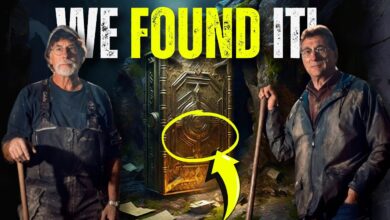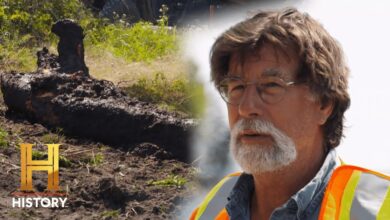The Curse Of Oak Island Is FINALLY OVER!
The Curse Of Oak Island Is FINALLY OVER!

At the start of a new season, the Oak Island team had been able to accomplish several of their goals despite the difficult challenges. They have become closer than ever before to discovering the whereabouts of the hidden treasure.
During the journey, several artifacts and findings have been gathered to give clues to what happened on the island and unveil the mysteries centered around the mythical land. Join us as we discuss eleven of the biggest, most important, and rarest finds of the Curse of Oak Island.
The beginning of the season was filled with hope and excitement about what was to come. The team was pumped with curiosity, goals, and how to achieve them. Fortunately, the week has much more in stock than they hoped for. Different and new exciting discoveries, as well as furthering their steps confidently into the new season.
On Lot 5, the archeology team Laird Navin, Jamie Kouba, and Fiona Steele continue their task of excavating the mysterious area and, of course, the recently discovered circular stone depression that seems to contain much more details than the rest of the explored area on Lot 5.
During the start of the excavation, Laird stated that the main goal was to expose the bottom of the feature, but he was in for a surprise at the rate at which new discoveries were made. Sooner than expected, Fiona made the first discovery of the season and alerted Jaime of what was found in the midst of the debris and lumps of soil in the feature. It was small pieces of red earthenware which were used for storage and transport of goods and materials in North America and Europe during the 17th to 18th centuries.
After observing the earthenware, Laird stated that the glaze was unusual with a hint of purple and black color on its surface. However, what was more fascinating about the earthenware was that it was unrecognizable to Laird, who is an expert. This gives a clue that the pieces found are from earlier times, at least the 1600s, which was before the discovery of the Money Pit.
Was there a chance that the circular depression was mistaken as the Money Pit and covered up so the treasure was protected from being found by searchers? There is also a linked ongoing theory that the digging of the circular feature was prompted by the idea of it being the treasure spot. Another indication is that the island was long ago inhabited by unknown dwellers before it was discovered in the 1940s and before it was divided into Lots.
In Laird’s opinion, the only answers that can be collected are in the feature itself, and the further down it is being excavated, the older the artifacts are and the more answers can be gotten. After Rick, Marty, and Gary join the team at Lot 5 and detect some evidence of iron in the circular feature, Fiona makes yet another discovery: a piece of pottery. This time, the piece is difficult, much thicker than the former, and identified by Laird to be coarse earthenware and possibly older than the previously found pieces.
From the several spots that indicated the presence of iron, Laird, while carefully digging, found an iron artifact almost at the edge of the lumped and thick soil in the feature. He alerted Marty of discovering the source of the previously found metal hit and after careful sorting and digging, the artifact seemed to take a much more identifiable shape.
After minutes of observing the artifact, Marty stated that he thought it was an iron latch and Laird agreed that it belonged to either a seller or a trap door. If this is true, then it seems the Lot 5 circular feature has much more to hide than is perceived. As the saying goes, if there is a latch, there is a hidden structure. The unanswered question remains: “What is underneath the circular feature?”
Marty, Rick, and Craig get more info on the iron latch by visiting the interpretive center to get an analysis from Laird and Emma. After using a CT scanner, Emma was able to give a clear image of the artifact in its original state. From Marty’s point of view, it bears semblance to a door knocker, especially considering its pointy tail. Also, its structure gives a clue of its purpose, which Marty also stated must have been driven into an object and meant to be a permanent part until it broke off due to soil activities, rusting, and aging.
On a closer observation, the top of the latch seemed to have a flattened surface unlike its pointy end, which indicates it was indeed hit—possibly by a hammer or even a stone—and driven into a structure. According to Laird’s expert opinion, the artifact seemed to be a river raft spike used for multiple purposes. Emma reported that the artifact had a high quantity of iron and no manganese, indicating it predates 1840.
What stands out even more is its difference when compared to other artifacts found on the island. There are no matches, but it does have a 100% match with artifacts recovered from the site of the original depositor of the hidden treasure, Sir William Phips. Considering the analysis result, it is safe to assume that the latch was a personal belonging of Sir Phipps. However, the mystery now is the reason why it was found in Lot 5 and who buried it in the circular depression.
Still on the hot spot, Lot 5, and a few yards away from the circular feature, Rick and Gary resume the operation of what they do best and are excited. The duo begins the season’s metal detection on Lot 5, starting from the metal magnet areas marked by flags. After getting a strong signal of metal presence, Rick carefully dug out the spot and they both realized the artifact they expected to find was very small in size.
Soon enough, amongst the several debris in his hand, there was a fascinating discovery. An ancient coin was unearthed. It most likely belonged to Roman origin, which based on the drawing and observation, seemed to have been hand hammered. The next flagged spot also gave a satisfactory signal and when carefully dug out, they were both excited to discover another ancient coin. The new coin was also hand-hammered, but it was also thicker, weighed more, and had a woven kind of design on its top.
On a closer look, the woven design seemed to look like chain links and is likely to be a culturally originated design. After further digging, it seemed that part of Lot 5 was either raining or growing coins because a third coin was found a few minutes after the former and in a flagged spot. When studied, Gary stated that the third coin had the same patina as the other two and that the coin is possibly more ancient than the rest.
Later in the day, the team goes back to take their chance on finding another coin or important artifact. Amazingly, a fourth coin was found. It is the same size as the others and is also ancient. However, what differentiates it is the design at its top. What is it about Lot 5 that makes it enriched with artifacts and treasures? Is there an explanation for the several coins found in Lot 5? Perhaps it was a route used to transport hidden treasures to the Money Pit and some of the found coins were falling from the movement.
At the interpretive center, Marty, Rick, Craig, and Gary all await the analysis of the newly found coins.
In an attempt to explore the swamp, the team’s resident diver Tony is accompanied by Alex, Jack, the ROV, and the rest of his team. Underwater, after fanning debris off the potential artifact, it was revealed to be a piece of hand-carved timber, a piece of pottery with blue markings, and a sailor’s clay pipe stem. Is there a chance that connects the artifacts in the swamp to those found on Lot 5 because they seemed to have similar features? According to Alex, it seems this part of the swamp was a deposit site buried by water over the years.
Moving closer to the underwater boulder, Tony found a metal detector hit and repeating the pattern of fanning, he found a round metal object with a circular hole in the middle and identified it to be a potential coin, similar to the ancient Chinese coin previously found. After more observation, he stated that it could also be a disc of some sort. Until it is retrieved, there is no confirmation of what it is. Tony also stated that the artifacts found are very similar to those found on land and there is a possibility of it being a part of a shipwreck or being brought into the island by visitors or traders.
Carefully digging through the circular feature on Lot 5, after numerous rocks were removed, Jaime, who was assigned to a portion where a particularly big rock was previously removed, dug and hit something she considers very important. She alerted the rest of the team about what could be the biggest artifact discovery in Lot 5’s circular feature.
After careful digging, she was able to remove a very large and wide piece of pottery from the hole. After several moments of observation, Laird concluded that it was a coarse earthenware, popularly known as the Anglo-American ware. He stated that the large piece most likely originated from England or Pennsylvania and based on its look, it was a large cooking vessel.
When inquired about its date of creation, Laird expresses his belief that it was made in the second half of the 1700s, most likely the 1770s. The creation of the pottery is further than the discovery of the Money Pit, which gives a possible clue about who brought it into the island. Was the piece of pottery a cooking vessel for those who created the circular feature or by those who dwelled on Lot 5? There is also a possibility that the feature might have been found on Lot 5 and scattered over the structure to give the feature an illusion of being regular ground or an area affected by soil activities.
Continuing to explore other areas of Lot 5 aside from the circular








